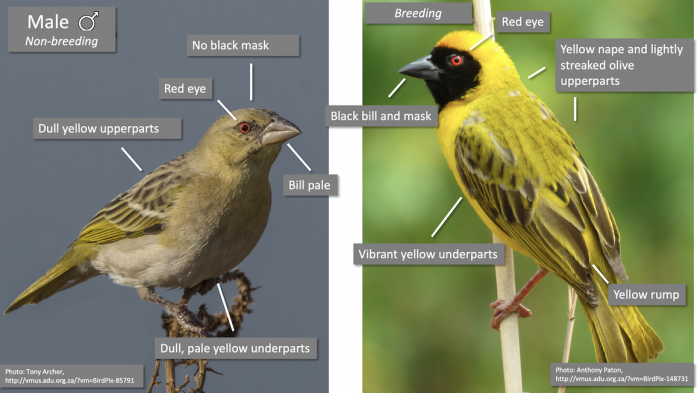Identification
The Southern Masked Weaver is a medium-sized, brightly coloured bird. Males and females look similar outside of the breeding season but are easily distinguishable in breeding plumage.

Breeding: Anthony Paton, Northcliff, Gauteng. September 17 2017. BirdPix 148731
Breeding males have olive green upperparts streaked with grey and brown. The eyes are deep red and the bill is black. The underparts are vibrant yellow, and the trademark of a breeding male is its black face mask, running from the forehead all the way down to the throat.
Non-breeding adult males also have reddish eyes, but the red is duller than in breeding males. the bill becomes a pale brownish colour, and the mask disappears. Non-breeding males are also duller yellow overall with paler yellow underparts.

Adult females closely resemble non-breeding males; the upperparts are dull yellowish-green streaked with dark brown, and the underparts are pale yellow. During the breeding season, the throat and breast are bright yellow; outside of the breeding season, they are paler in colour. Females have pinkish-brown bills and dark brownish eyes. Juvenile Southern Masked Weavers are almost identical to non-breeding females—it can be difficult to tell them apart!
Southern Masked Weavers produce a buzzy, swirling song, similar to the Cape Weaver.
You can watch a male singing and displaying in this video by Lynette Rudman:
Habitat
Southern Masked Weavers primarily feed on insects and seeds, but will also eat fruits, flowers, and nectar.

They forage in small groups in grasses, trees and on the ground, and often visit garden seed feeders. Southern Masked Weavers can be found in open, shrubby habitat in dry areas and along rivers, as well as in agricultural land with some tree cover.
Distribution
The Southern Masked Weaver is a near-endemic species; its range is almost entirely confined to southern Africa.

This species is widespread across southern Africa except for a few patches of treeless desert in Namibia, and is less common along the eastern coastlines of South Africa and Mozambique.
Behaviour
Southern Masked Weavers are gregarious and are most often seen in large or small flocks. Outside of the breeding season, these flocks may contain other seed-eating species. They typically sleep in large communal roosts in reedbeds or trees and in the morning, will gather into smaller groups to forage.
Southern Masked Weavers Weavers are colonial nesters, meaning that several birds may nest close together. Birds in the weaver family have some of the most fascinating nesting strategies and structures of any birds in the world.

R: Mark Stanton, Nigel, Gauteng. 30 November 2020. BirdPix 141397
Male Southern Masked Weavers weave their globular nests from broad grasses, palm leaves, or reeds.
Southern Masked Weavers are polygynous, meaning that one male may mate with several females in a single breeding season. Males display outside their nests to attract potential mates. Once the female has selected a nest, she will line it with grass, leaves, and soft feathers. Nests are built in a variety of locations including trees and palms, bushes, reeds, and fences.

PHOWN 226; lower R: Vincent Ward, Northern Cape. 10 October 2015. PHOWN 18443
Further resources
Species text in the first bird atlas (1997)
Birds4Africa: Weaver News
Virtual Museum (BirdPix > Search VM > By Scientific or Common Name)
More common names: Swartkeelgeelvink (Afrikaans); Tisserin à tête rousse (French); Maskenweber (German); Tessitore velato (Italian) Tejedor enmascarado(Spanish)
List of bird species in this format is available here.
Recommended citation format: Daniel KA 2021. Southern Masked Weaver Ploceus velatus. Biodiversity and Development Institute. Available online at https://thebdi.org/2021/11/11/southern-masked-weaver-ploceus-velatus/

